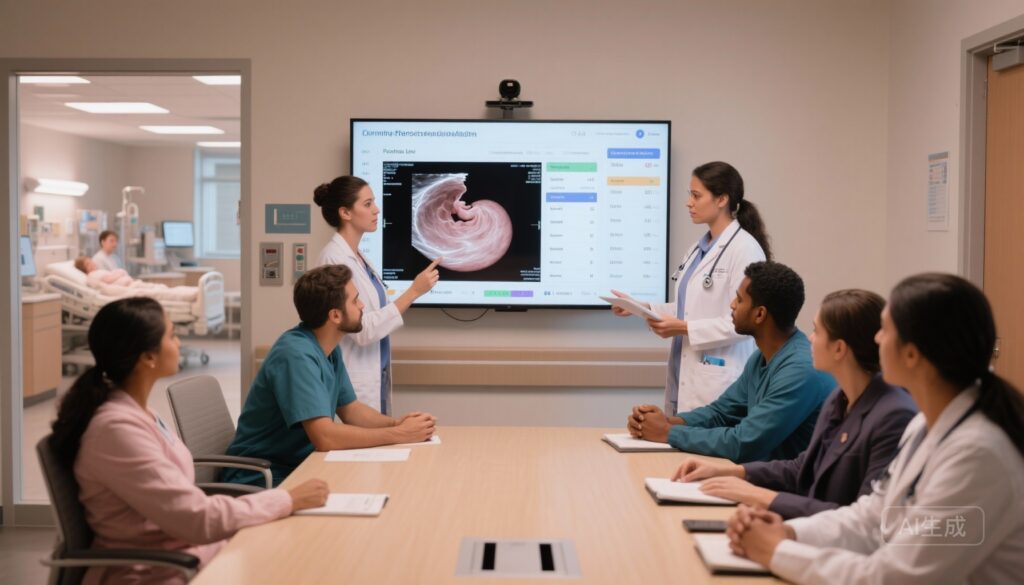Highlights
– A national clinician-led programme in Australia (Phase 1, 2018–21) was associated with a 6.8% relative reduction in singleton preterm births at the population level, driven by falls in births at 32+0 to 36+6 weeks.
– Early-term (37+0 to 38+6 weeks) singleton birth rates rose nationally during Phase 1 but fell markedly (9.6% relative reduction) in 59 hospitals participating in a Breakthrough Series Collaborative (Phase 2, 2022–24).
– Multifaceted implementation of known clinical strategies (avoidance of unnecessary early birth, midpregnancy cervical length screening, and vaginal progesterone for short cervix) can deliver measurable improvements across a high‑resource national system; preventing very early spontaneous preterm birth remains a major challenge.
Background and disease burden
Preterm birth (delivery before 37 completed weeks of gestation) is the leading direct cause of neonatal mortality and a major contributor to long‑term neurodevelopmental impairment and childhood morbidity. Globally an estimated 15 million infants are born preterm each year, with substantial short‑ and long‑term health, social and economic impacts. Many high‑resource health systems have concentrated on reducing iatrogenic early births while also implementing evidence‑based strategies to prevent spontaneous preterm birth in selected risk groups.
In Australia, as in other high‑income settings, reducing avoidable preterm and early‑term births is a priority because birth before full term is associated with higher neonatal respiratory and feeding problems, longer hospital stays, and later developmental issues. Evidence supports targeted interventions such as universal or risk‑based cervical length screening in midpregnancy and the use of vaginal progesterone for women with a sonographically short cervix, but implementation at scale is variable.
Study design and programme description
The reported work evaluated a national preterm birth prevention programme in two sequential phases.
Phase 1 (2018–21): national clinician‑led education, retrospective population analysis
Phase 1 was a whole‑of‑national‑population, implementation programme focused on clinician education and awareness. Key clinical components promoted included reducing unnecessary early birth (elective or indicated), midpregnancy cervical length measurement, and prescribing vaginal progesterone where indicated. Outcomes were assessed in an ecological, retrospective analysis using official national birth data from the Australian Institute for Health and Welfare (AIHW). The analysis included liveborn singleton births ≥20+0 weeks gestation across Australia from 2017 baseline through 2021.
Phase 2 (2022–24): Breakthrough Series Collaborative, pre–post hospital‑level analysis
Phase 2 added a quality improvement (QI) Breakthrough Series Collaborative (a structured, rapid‑cycle improvement method developed by the Institute for Healthcare Improvement) involving 59 maternity hospitals across all Australian states and territories. Participating sites provided record‑level data to Women’s Healthcare Australasia. The Phase 2 analysis compared a 21‑month pre‑Collaborative baseline period with three sequential 7‑month Collaborative time periods (total 21 months) to assess changes in preterm and early‑term singleton livebirth rates.
Endpoints and statistical methods
Primary outcomes across both phases were rates of preterm birth (20+0 to 36+6 weeks) and early‑term birth (37+0 to 38+6 weeks) among liveborn singletons ≥20+0 weeks. Phase 1 used Poisson regression on national aggregate data; Phase 2 used Poisson regression on record‑level hospital data. Phase 1 examined temporal trends between 2017 and 2021; Phase 2 compared pre‑Collaborative and Collaborative periods.
Key findings
The study reports complementary system‑level and hospital‑level findings.
Phase 1 — national population (2018–21)
– Included births: 1,479,125 live singleton births ≥20+0 weeks.
– Preterm birth rate fell from 6.40% in 2017 to 5.97% in 2021, an absolute reduction of 0.43 percentage points and a relative reduction of 6.83% (incidence rate ratio [IRR] 0.93, 95% CI 0.91–0.95; p < 0.0001).
– The reduction in preterm births was concentrated in the later preterm window (32+0 to 36+6 weeks); there was no reported reduction in the earliest gestational age strata.
– Early‑term (37+0 to 38+6 weeks) singleton births increased nationally from 30.58% in 2017 to 32.17% in 2021 (absolute increase 1.59 percentage points; relative increase 5.22%; IRR 1.05, 95% CI 1.04–1.06; p < 0.0001). The authors attribute this, in part, to shifts in timing of deliveries as iatrogenic timing practices evolved.
Phase 2 — Breakthrough Collaborative hospitals (Oct 1, 2022 – Jun 30, 2024)
– Included births: 458,542 live singleton births across participating hospitals.
– Early‑term singleton birth rate in participating hospitals decreased from 30.63% in the pre‑Collaborative period to 27.69% in the third (final) Collaborative period — a 9.60% relative reduction (IRR 0.90, 95% CI 0.89–0.92; p < 0.0001).
– Preterm birth rates did not decrease further in participating hospitals during the Collaborative period compared with baseline.
Safety and unintended effects
The report highlights that reductions occurred without measurable increases in preterm birth at earlier gestations in Phase 2, and there is no signal reported of shifting harms (for example, increases in stillbirth) in the aggregated analyses presented. However, detailed neonatal outcome data (e.g., NICU admissions, respiratory morbidity), maternal complications related to interventions, or disaggregated outcomes by indication (spontaneous vs iatrogenic preterm birth) were not reported in detail in the summary data presented here.
Expert commentary and interpretation
This national programme offers several important insights for clinicians, health system leaders and policy makers.
First, the modest but statistically robust national decline in preterm births seen during Phase 1 suggests that coordinated clinician education and dissemination of established preventive practices can change outcomes at population scale in a high‑resource setting. The concentration of benefit in later preterm gestations (32+0–36+6 weeks) is consistent with the idea that implementation strategies more readily prevent iatrogenic and some medically modifiable causes of later preterm birth, and that preventing very early spontaneous preterm birth requires additional, more targeted biological interventions.
Second, the increase in early‑term births nationally during Phase 1 is a reminder of the potential trade‑offs when efforts to reduce preterm birth alter delivery timing without explicit protocols to avoid elective early‑term delivery. The subsequent Breakthrough Collaborative (Phase 2) demonstrates that QI methodology — multidisciplinary teams, local audit, feedback, and shared learning — can successfully reduce early‑term birth rates in participating hospitals, likely by aligning decision‑making around timing of birth, strengthening policies to avoid non‑indicated early deliveries, and standardising use of cervical length assessment and progesterone where appropriate.
Third, the failure to reduce very early preterm births highlights persistent gaps. Biological pathways leading to spontaneous early preterm labour (e.g., infection/inflammation, placental pathology, cervical remodeling) remain incompletely preventable with current tools. This finding underscores the need for ongoing research into predictive biomarkers, novel therapies, and more effective translation of existing prevention strategies to high‑risk individuals.
Limitations and generalisability
Important limitations should temper interpretation. Phase 1 used an ecological, population‑level design; causality cannot be proved and secular trends or other concurrent changes in practice might contribute. Phase 2 used pre–post analyses within participating hospitals; these designs are susceptible to selection bias (hospitals that elect to join collaboratives may be more engaged) and to temporal confounders. Detailed maternal and neonatal secondary outcomes, process metrics (e.g., rates of cervical length screening, progesterone prescriptions), and subgroup analyses (e.g., spontaneous versus medically indicated preterm birth) are needed to elucidate mechanisms and safety. Nevertheless, the magnitude and consistency of observed changes, combined with biologically plausible intervention targets, support a likely beneficial effect of the programme elements at scale in a well‑resourced health system.
Implications for practice and policy
For practitioners and health system leaders aiming to reduce preterm and early‑term births, this work supports several pragmatic steps:
– Implement standardised midtrimester cervical length screening pathways in appropriate populations and ensure systems to act on short cervix findings (referral pathways, prompt access to vaginal progesterone).
– Develop and enforce clear institutional policies to avoid elective early‑term births unless medically indicated, with audit and feedback on early‑term delivery rates.
– Use QI collaboratives (Breakthrough Series or similar) to accelerate local adoption, share best practices, and sustain improvements.
– Maintain surveillance of balancing measures (stillbirth, neonatal morbidity, maternal complications) alongside process metrics to detect unintended consequences early.
Research priorities
Key research needs remain. Randomised and implementation trials to determine best approaches for universal versus risk‑based cervical length screening, optimal progesterone formulations/dosing and duration, and strategies to prevent very early spontaneous preterm birth are high priorities. Trials and registries that capture neonatal outcomes, maternal side‑effects, cost‑effectiveness, and equity impacts (particularly for Indigenous and disadvantaged populations) will be essential to guide policy at scale.
Conclusion
The Australian national prevention programme demonstrates that coordinated, evidence‑based clinical practice changes and structured quality improvement at scale can reduce late preterm and early‑term births in a high‑resource setting. While gains at later gestations are encouraging, continued work focusing on preventing very early spontaneous preterm birth and on robust measurement of neonatal outcomes is required to further reduce the burden of preterm birth.
Funding and clinical trial registration
Funding for the programme and associated evaluation was provided by the Australian National Health and Medical Research Council, Health Department of Western Australia, Health Department of New South Wales, Health Department of Victoria, Western Australian Channel 7 Telethon Trust, and the Commonwealth Government of Australia. No ClinicalTrials.gov identifier was reported for the national programme analyses described here.
Selected references
1. Newnham JP, Silver RM, Middleton P, et al. Reducing rates of preterm and early‑term singleton births safely in Australia: results of the national prevention programme. Lancet Obstet Gynecol Women’s Health. (Article as provided).
2. Blencowe H, Cousens S, Oestergaard MZ, et al. National, regional, and worldwide estimates of preterm birth rates in the year 2010 with time trends since 1990 for selected countries: a systematic analysis and implications. Lancet. 2012;379(9832):2162–72.
3. Dodd JM, Grivell RM, O’Brien CM, et al. Progesterone for preventing preterm birth in women with a singleton pregnancy and previous spontaneous preterm birth. Cochrane Database Syst Rev. 2013;7:CD004947. (Updated reviews on progesterone for short cervix and previous preterm birth are available.)
4. Hassan SS, Romero R, Vidyadhari D, et al. Vaginal progesterone reduces preterm birth and neonatal morbidity in women with a sonographic short cervix: a randomized controlled trial. N Engl J Med. 2011;365:1997–2006.
5. Institute for Healthcare Improvement. The Breakthrough Series: IHI’s Collaborative Model for Achieving Breakthrough Improvement. IHI White Paper. 2003. https://www.ihi.org/resources/Pages/IHIWhitePapers/TheBreakthroughSeriesIHIsCollaborativeModelforAchievingBreakthroughImprovement.aspx
6. Australian Institute of Health and Welfare. Births in Australia. AIHW data and reports on births and perinatal outcomes. https://www.aihw.gov.au/reports/mothers‑babies
Note: Readers should consult the full Lancet Obstetrics, Gynaecology & Women’s Health article by Newnham et al. for complete methods, supplementary analyses, and detailed outcome tables.



